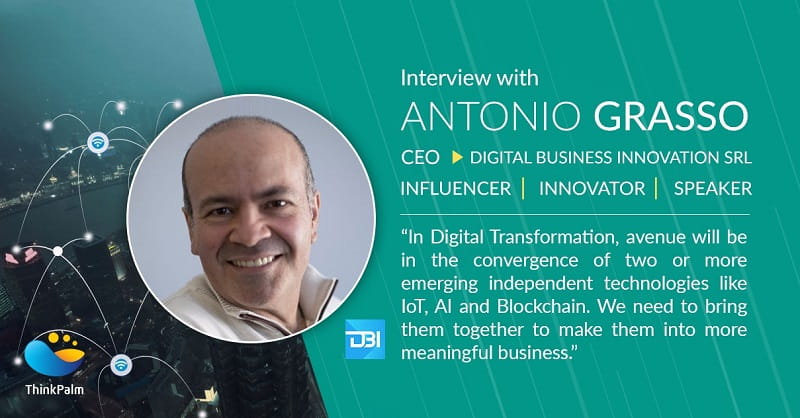
Antonio Grasso who began as a developer and software architect in the IT business has driven substantial projects for the Italian Government. Founder and CEO of Italian company Digital Business Innovation, Antonio is regarded as one of the top Digital Transformation influencers. Being a highly respected analyst, spokesman and an IoT expert, Antonio will be answering our questions on how Internet of Things and emerging technologies could revolutionize the way our businesses work today.
Among all the industries that are adopting IoT, according to you which industry is making the fastest and best use of IoT?
It is very hard to say because Internet of Things is disrupting many industries today. I think industrial automation in manufacturing is something that has been adopting IoT at a faster rate because they need to go beyond the normal automation based on RFID(radio frequency identification). Insurance is also doing many investment on Internet of Things. But for sure yes, manufacturing is doing the best investment on IoT.

Source : statista.com
How about Healthcare industry?
Healthcare is also a good consumer of IoT. There are many devices that are now intelligent and smart to permit/collect together patient data. The evolution of IoT in healthcare will be in wearables because it can embed IoT devices. They come in the form of bands, watches or bracelets which is more comfortable to wear. Technology advancement can also be seen in the form of smart clothing where you can see IoT devices being embedded in shirts. I think in future we can see more of wearable IoT where the technology can be seen embedded in garments.
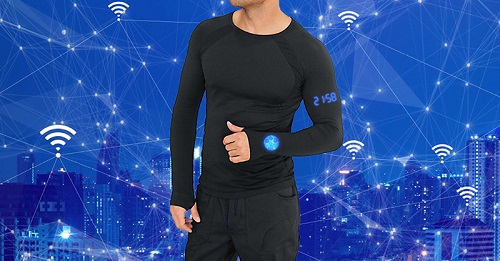
IoT in Garments
A lot of hardware devices are being replaced by IoT devices for monitoring data especially in health industry. What do you think are the challenges faced during this transformation.
I think the first challenge is the security related to collecting data using wearables because we are talking about sensitive data that is being exchanged. Strengthening cybersecurity is very important because we have a lot of data that can be intercepted or stolen while communicating through these devices. Also in health care, some devices are life savers like that of oxygen pumps. It is very important to create a better security against cyber attacks as they can interfere with the data which is very dangerous. Manufacturers have to be vigilant about identifying risks and hazards associated with their medical devices. In general, issues related to cyber security is blowing down our potential growth that we have in our digital transformation. This is a big issue.
Second issue I see is data privacy. To whom and what kind of permission you need to release to use the data that is better for the patient. Communication is not a problem anymore. Today we have 4G and we are on the way to 5G, so connection is not a big issue in this situation. But security is.
As we rely on connected technology in our day-to- day lives, the more vulnerable we are to the cyber threats that are increasingly tailored to exploit vulnerabilities and design flaws in IoT devices. What do businesses need to do to protect themselves from the same?
One solution is the continuous update of device. Many devices use firmware, software that needs to be be updated frequently. You can build good communication, crypto communication but if the device is not updated, you are more susceptible to cyber threats. Many cyber attacks like you said are tailored to exploit the flaws that exist in firmware or software devices engaging to explore the device at the point of failure. Hence continuous update should be the first step that businesses should take if they are to implement IoT.
Second would be the architecture of the IoT system. Companies should also focus on updating the infrastructure by updating the architecture of the IoT system to handle more requirements. Educating people on sharing the correct data especially when we talk about healthcare technology is also very important.
Today, we see the driverless cars a reality after a constant research and development effort for past fifty plus years. Navigation, guidance, driving, managing the car’s internal system for better performance are all made autonomous. Still, a lot of countries are resisting the push towards driverless cars. What according to you are the biggest risks associated with it? Do we have a solution for it?
If we talk about autonomous vehicle we can talk generally about autonomous things. It can be a car or just working vehicle in the industry, we see them working independently without human presence. There is no human presence required to run the vehicle. Computer systems controlling self-driving cars may have glitches and like I said before cyber threat also adds on to it. We have a responsibility towards humanity. Safety of the individual is very important. This should be one reason why some countries are not accepting autonomous vehicle.
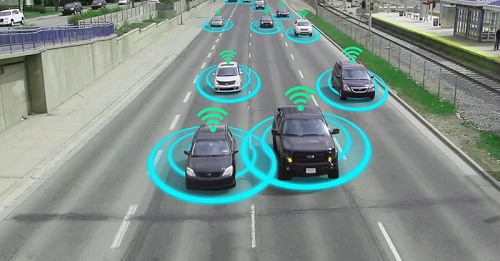
Autonomous Cars
Particularly in autonomous vehicle I see that in future, the digital twin can help us tackle cyber attacks to an extent. Digital twin is the digital replication of the physical object. If we need to collect data from device we can digitize physical object using digital twin and then we can talk with the twin and not with the object.That is, we can create a secure connection between the vehicle and the digital twin and hence we can talk to the digital representation of the object and not directly to the vehicle. This can enhance the security of the autonomous vehicle. This is not a full resolution of the problem but it can mitigate the risk to a great extent.
The International Energy Agency outlines a rise of 55% in the global demand for energy between 2005 – 2030. What’s your say on the potential of IoT for providing the infrastructure for decentralised, smarter energy grids and a stable supply of power?
Interesting question! Energy sector is shaped by a 3D phenomena – digitalization, decentralization and decarbonisation. I think we need to consider all these phenomena when trying to figure how IoT can help. In energy sector, I can see the digital twin of the power plant that can be interesting to implement which is more secure.
I really think the union of IoT with some other technologies, especially the convergence of smart contract, blockchain and IoT can foster new ways where we can see energy decentralization. That is because when it comes to energy, consumers are today becoming prosumers i.e producer and consumer. Blockchain along with smart contract could empower such ‘prosumers’ to sell the energy that they have generated directly to their neighbors. That is you can generate energy in the roof of your house and then you can share the excess energy that you use with others. This technology combination can initiate and transmit data in a secure manner.
Many people talk about blockchain but we need to clarify that blockchain is just a database, it is a huge digital database. Smart contracts are coupled with business and application layer of blockchain to keep, track and transact these relevant information of all the users within the network. In this way, the users don’t need to depend on a central system for their exchanges and transactions and a decentralized chain is formed. This can foster new innovation in energy sector.
In the world of technology, we’ve been transforming a lot of impossibilities to possibilities. In next 10 or 20 years,according to you what changes are we going to see in Digital Transformation in Businesses? Can you tell us what changes are expected ahead?
10 years to 20 years is a very long time. I am a visionary, but I cannot predict what will happen in 10 years or 20 years. This is because looking at the rate which the technology is growing, many things happen in a day. But yes I can talk about things that we can expect in next 3 to 5 years. In the digital transformation, avenue will be in the convergence of two or more emerging technology. Today the emerging technologies like IoT, AI, Blockchain are considered as independent technologies that are in development. We need to bring them together to make them more meaningful business. For example, we spoke before that in energy sector consumer will become prosumer with convergence of technologies like smart contract, blockchain and IoT. I’m also curious to see how the convergence of RPA (Robotic Process Automation) and AI can bring about changes in business . It will be very interesting to see in next few years how Machine Learning can help fulfill business processes, fostering new wave of intelligence and cognitive process automation.
If you take business, you can see a lot of business processes are based on transaction. In these cases, smart contracts act as blockchain enablers for business process. Smart contract adoption in enterprise can bring a lot of benefit. We have IoT that use secure transaction by smart contract and blockchain that can be included in business process letting machine to machine to talk in process for enterprise.
When we talk about Internet of Thing we need to talk about Digital Twin. It is a technology which can bring more security and is more flexible to manage, as we are communicating with the digital representation of the physical object and not the object itself.
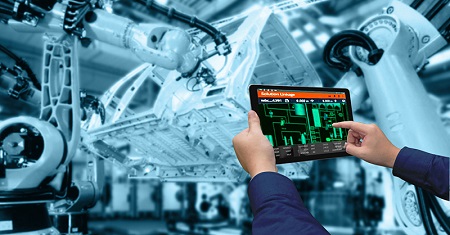
Digital Twin in Manufacturing
If we consider these technologies as dimensions, IoT and smart contract can be taken vertically in industrial and business process.If you can imagine a matrix horizontally, I can see Artificial Intelligence to be the governance of technology adoption in the business process. The governance is something that decides what to do when something happens For eg: if this, then do this, is a static logic.We need to put a piece of code that instructs the device to learn from experience based on this static logic. It provides systems the ability to automatically learn and improve from experience without being explicitly programmed. Many chip producers are producing new chip sets with machine learning instructions inside that can learn from experience. In other words, Machine learning along with AI helps the machine learn from its experience so that it can behave human-like and improve over the course of time. Many producers are creating new chip set with the machine learning instructions inside which can learn from experience.
Another thing that I see in the next years to emerge is the Edge Computing. Edge computing is really interesting because you do not need to move the data from device to cloud. All the computations can be handled in the edge device itself. There are a lot of data going from device to cloud then analytics analyse the data, make decisions but with edge analytics we can have decisions brought to the edge so you don’t need to move data from devices to the cloud. The data will remain there. I think Intel is also very active in generating next generation chipset based on this, for example the Quark.
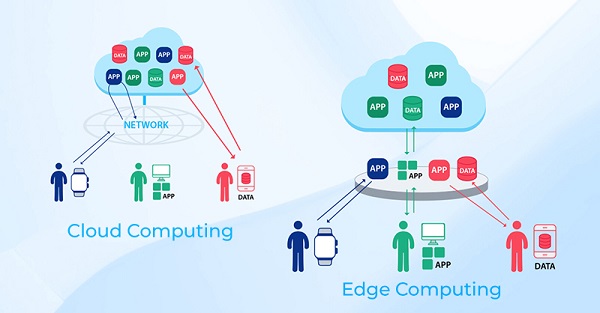
Difference between Cloud Computing and Edge Computing
I really think the convergence of two or more emerging technology can really create wonders in the future. I’m curious about that.
So you see here that things are developing very fast. I’m quite blind to predict what will happen in next 10 to 20 years.
Interviewer

Gincy is a Digital Marketing Expert and has extensive experience in SEO Off-Page strategies, loves socializing and reading. If not working you can usually find her in the hip new restaurants around town.



